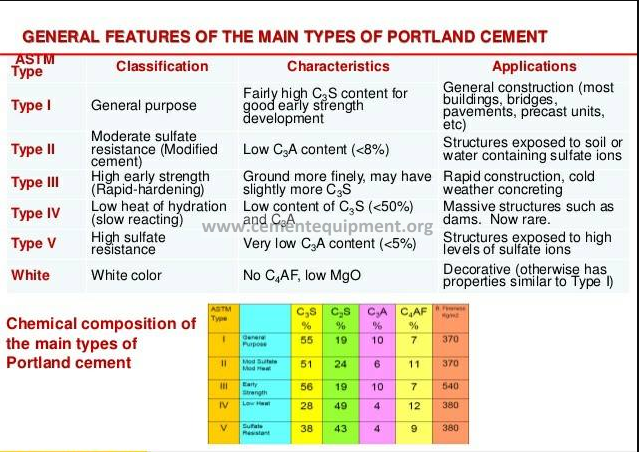Contents
CEMENT CHEMISTRY & TYPES OF CEMENT
Cement is a hydraulic binder, i.e., an inorganic, non-metallic, finely ground substance which, after mixing with water, sets and hardens independently as a result of chemical reactions with the mixing water and, after hardening, it remains its strength and stability even under water. The most important area of application is therefore the production of mortar and concrete, i.e., the bonding of natural or artificial aggregates to form a strong building material which is durable in the face of normal environmental effects.
Portland cement is the name given to a cement obtained by intimately mixing together calcareous and argillaceous, or other silica, alumina, and iron oxide bearing materials, burning them at a clinkering temperature, and grinding the resulting clinker. Nevertheless, cement can be considered as being in frozen equilibrium, i.e., the cooled products are assumed to reproduce the equilibrium existing at the clinkering temperature.
Major Compounds in Cement: In all the Portland Cements, there are four major compounds. The variation in percentage composition of compounds influences the properties of cement. These compounds are given in table 1.1 below:
Table 1.1
Composition of cement
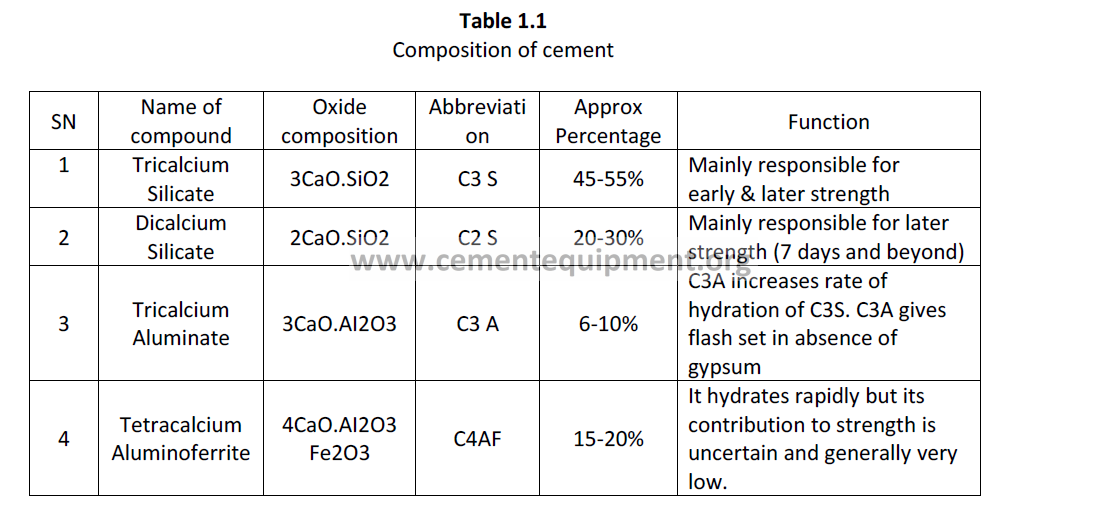
These main phases are present in the clinker and in the non-hydrated Portland cement.
They are formed at high temperature (1450 °C) in the cement kiln. Compounds referred as C3S, C2S,
C3A and C4AF are known as the main crystalline phases of Portland cement. The phase composition
of a particular cement can be quantified through a complex set of calculation known as the Bogue
Formula.
Main phases in Portland cement before and after hydration:
These oxides are used to build more complex compounds. The main crystalline phases described hereafter are related respectively to the composition of:
• Clinker and non-hydrated Portland cement, and;
• Hardened cement pastes obtained after hydration and cement setting.
• Hydrated cement paste
• Hydration products formed in hardened cement pastes (HCP) are more complicated, because many of these products have nearly the same formula and some are solid-solutions with overlapping formula. Some examples are given below:

- The hyphens in C-S-H indicate a calcium silicate hydrate phase of variable composition, whilst CSH indicates a calcium silicate phase CaH2SiO4.
Different types of cement produced:
> Ordinary Portland Cement (OPC): This is by far the most common cement used in general concrete construction when there is no exposure to sulphates in the soil or in ground water. In consequence, modern cements have higher 28 days strength than the past, but the later gain in strength is smaller. A practical consequence of this is that we can no longer expect ‘improvement with age’. Ordinary Portland cement is the cement most widely used. Moreover, using highly early strength cement for a given specified 28 days strength of concrete, it is possible to use a leaner mix, with higher water/ cement ratio. Some of these mixes have an inadequate durability.
> Portland Pozzolana Cement (PPC) contains up to 35% fly ash. The fly ash is pozzolanic, so that ultimate strength is maintained. Because fly ash addition allows a lower concrete water content, early strength can also be maintained. Where good quality cheap fly ash is available, this can be an economic alternative to ordinary Portland cement.
As a rule, Portland Pozolana Cements gain strength slowly and therefore require curing over a comparatively long period, but the long term strength is high shows that similar behaviour occurs where the pozzolana replaces part of cement, but the long-term strength depends on the level of replacement.
>Portland Slag Cement (PSC) contains up to 70% ground granulated blast furnace slag, with the rest Portland clinker and a little gypsum. All compositions produce high ultimate strength, but as slag content is increased, early strength is reduced, while sulfate resistance increases and heat evolution diminishes. Used as an economic alternative to Portland sulfate-resisting and low-heat cements.
The hydration of slag is initiated when lime liberated in the hydration of Portland Cement provides the correct alkalinity; subsequent hydration does not depend on lime. Typical uses are in mass concrete because of lower heat of hydration and in sea-water construction because of a better sulphate resistance (due to a lower C3A content)than with ordinary Portland cement. Slag with a low alkali content can also be used with an aggregate suspected of alkali reactivity.
- It is necessary to use cement of appropriate grade and type for specific applications and environment conditions. Various type of cement produced in India are shown in table 1.1.
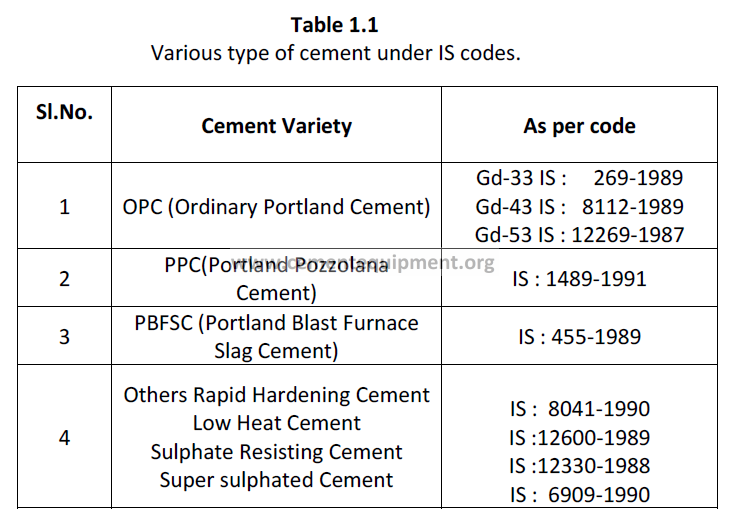
1.2 The physical and chemical characteristics of various cements are given in Table 1.3 & 1.4
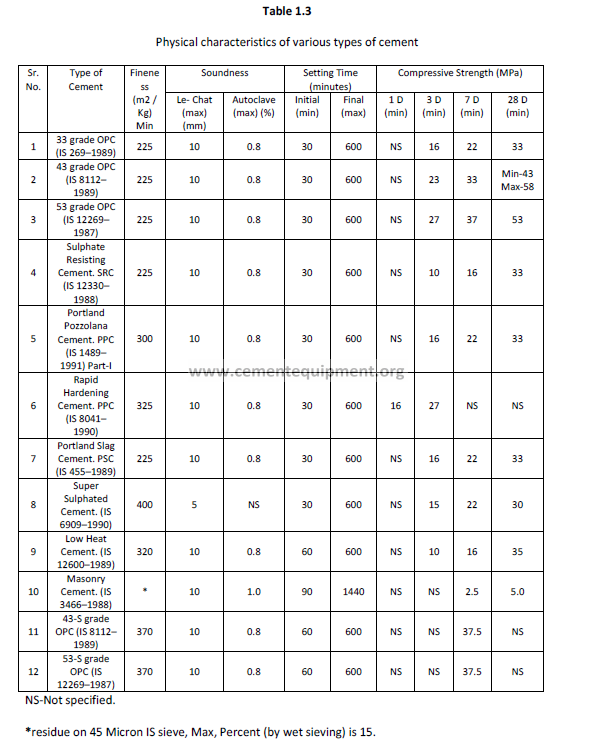
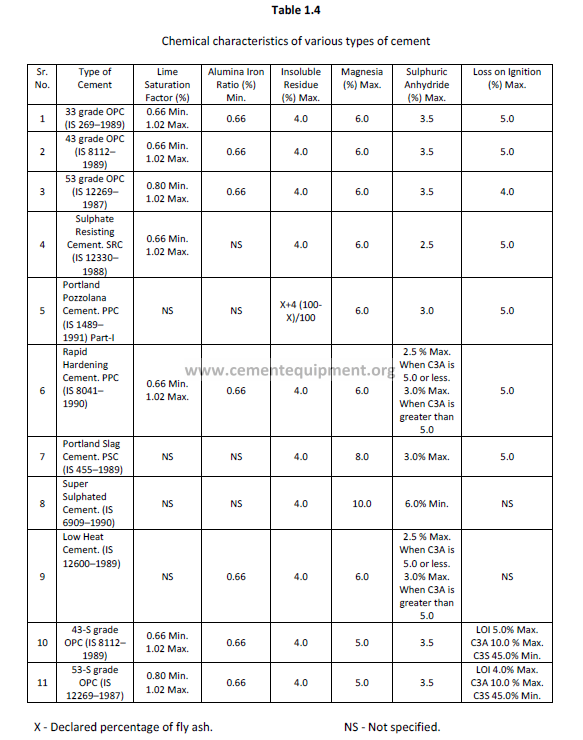
1.5 Factors affecting choice of cement: Following factors govern choice of cement.
Durability Characteristics
> Functional requirement – Deflection, crack width etc.
> Design parameters- Strength, fineness, setting time requirement etc.
> Speed of construction- Time for construction etc.
> Environmental Conditions- Ground conditions, soluble salts, sulphates, Chemical plants etc.
1.6 Suitability of various types of cement:
A. 33 grade OPC:
It is used for normal grade of concrete upto M-20, plastering, flooring, grouting of cable ducts in PSC works etc. The fineness should be between 225 and 280.
B. 43 grade OPC:
It is the most widely used general purpose cement.
For concrete grades upto M-30, precast elements.
For marine structures but C3A should be between 5 – 8%.
C. 53 grade OPC:
For concrete grade higher than M-30, PSC works, bridge, roads, multistoried buildings etc.
For use in cold weather concreting.
For marine structures but C3A should be between 5 – 8%.
D. Portland Slag Cement (PSC) i.e. OPC + granulated slag: It gives low heat of hydration. The slag should be more than 50% and upto 70%. It is used for ;
Marine and off shore structures- very high chloride and sulphate resistant.
Sewage disposal treatments works
Water treatment plants
Constructions which are expected to be attacked by dissolved chlorides and sulphate ions.
Should be mainly used for all future structures.
E. Portland Pozzolana Cement: IS: 1489(part-I) – 1991 (using flyash):
It gives low heat of hydration and reduces the leaching of calcium hydroxide. This cement should be used only after proper evaluation. This should be tested as per IS: 1489 (Pt I) – 1991. It is used for :
hydraulic structures- dams, retaining walls
Marine structures
Mass concrete works- like bridge footings
under aggressive conditions
Masonry mortar and plastering.
F. SRC- Sulphate Resisting Cement: (C3A < 5%)
Sulphate Resisting Portland Cement is a type of Portland Cement in which the amount of tricalcium aluminate (C3A) is restricted to lower than 5% and 2C3A + C4AF lower than 25%. The SRC can be used for structural concrete wherever OPC or PPC or Slag Cement are usable under normal conditions.
The use of SRC is particularly beneficial in such conditions where the concrete is exposed to the risk of deterioration due to sulphate attack, for example, in contact with soils and ground waters containing excessive amounts of sulphates as well as for concrete in sea water or exposed directly to sea coast . The IS 456 (revised draft code) has made elaborate provisions for use of particular type of cement against different percentages of soluble sulphate salts. These provisions are given in table 1.6 below:
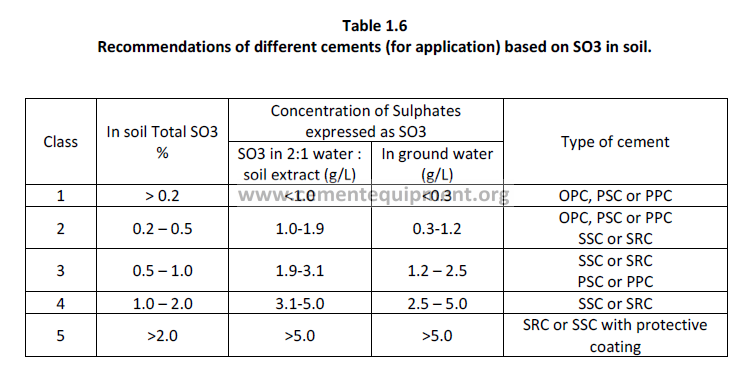
The use of SRC is recommended for following applications:
Foundations, piles
Basement and underground structures
Sewage and water treatment plants
Chemical factories
Suitable for underground works where Sulphate is present in the Soil and water.
Attention:
i) Sulphate resisting cement is not suitable where there is danger of chloride attack. This will cause corrosion of rebar.
ii) If both Chlorides and Sulphates are present, Ordinary Portland Cement with C3A between 5& 8 should be used.
Sulphate resistance of cements : Chemical resistance of various types of cement in different environmental conditions is given in table 6.7 .
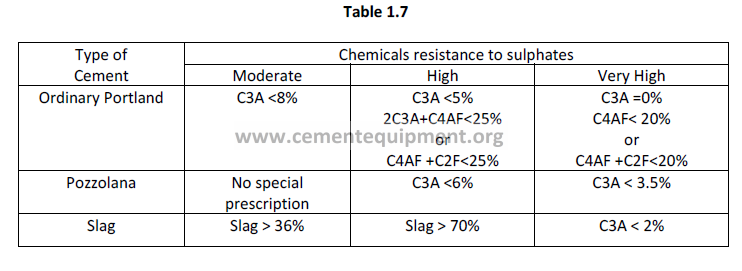
G. Low heat portland cement : Low Heat Portland Cement is particularly suited for making concrete for dams and many other types of water retaining structures, bridge abutments, massive retaining walls, piers and slabs etc. In mass concreting, there is often considerable rise in temperature because of the heat produced as the cement sets and hardens. The shrinkage which occurs on subsequent cooling sets up tensile stresses in the concrete, may result in cracking. The use of low heat cement is advantageous since it evolves less heat than OPC. This cement is not available in the market on regular basis and has to be obtained on specific orders.
H. Rapid hardening cement : The Rapid Hardening Cement is used for repair and rehabilitation works and where speed of construction and early completion is required due to limitations of time, space or other reasons. The cement is to be used in cold weather concreting i.e.
temp < 5 0C. Rapid hardening cement is basically OPC but its fineness is 3250 cm2/gm against 2250cm2/gm in case of OPC. The compressive strength after 1 day is 16 N/mm2 and that of 3 days 27N/mm2. These days higher grade OPC are available in the country to meet these requirements and therefore, this cement is not being manufactured and marketed on regular basis. The characteristics of this cement can be effectively met by only good quality 53 grade OPC.
I. Special grade cement (43-S and 53-S): Special Grade Cement is manufactured as per specification laid down by BIS IS 8112 & 12269. It is a very finely ground cement with high C3S content designed to develop high early strength required for manufacture of concrete sleeper for Indian Railways. This cement can also be used with advantage for other applications where high strength concrete is required. This cement can be used for prestressed concrete elements, high rise buildings, high strength concrete etc.
